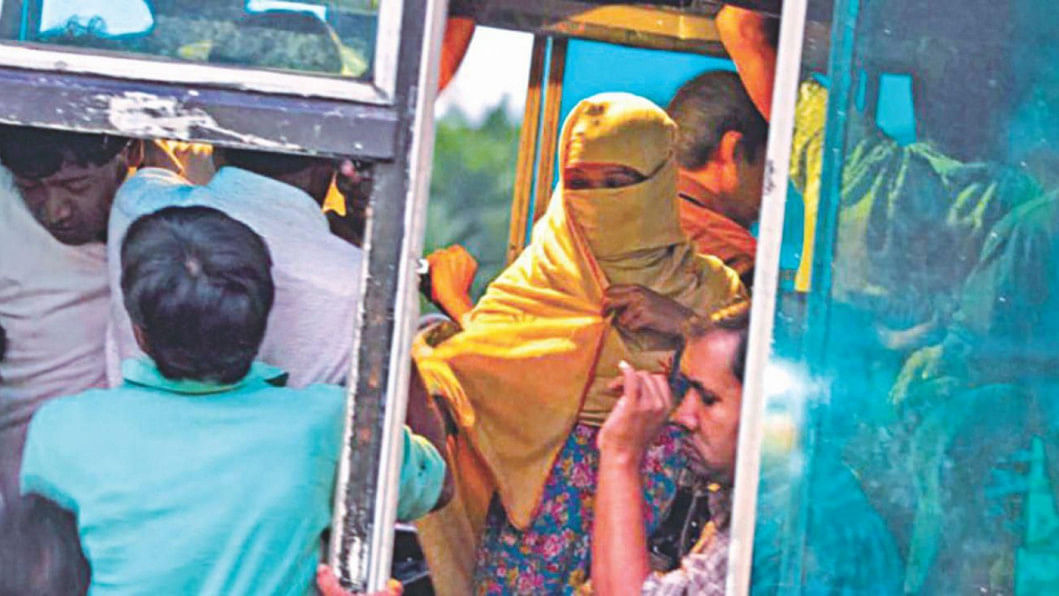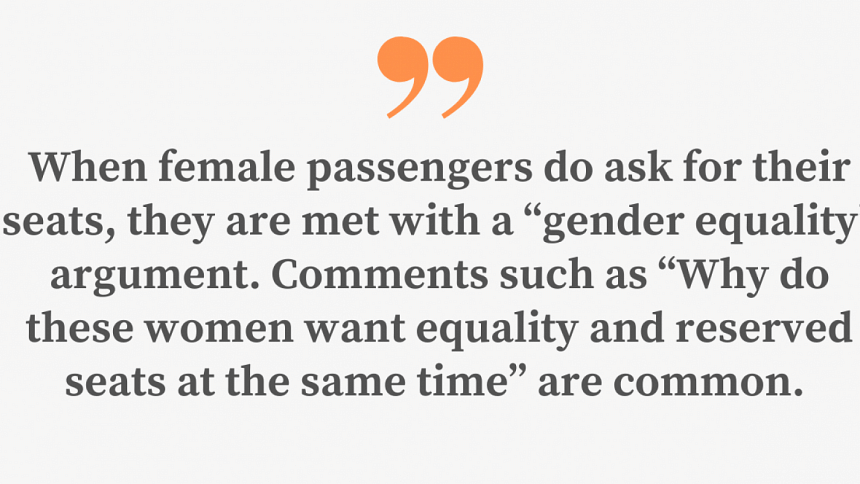Why do men have reservations about women’s reserved seats?

A local bus stops on the busy street of Dhaka's New Market area. Waiting commuters flock to the gate even though the bus is packed. For a woman in the city, it is a struggle to squeeze herself into the bus through the crowd. What adds to the distress is finding the seats reserved for women occupied by, most often, men.
In Dhaka, local buses are the cheapest and one of the most common ways of getting around. Each bus is supposed to have a certain number of seats allocated for women passengers, but said passengers often find men occupying those seats. Why do men do so, and why do women feel reluctant to reclaim the seats reserved for them? As part of a study, we asked a few regular commuters, both male and female, about their perspectives and experiences regarding this issue.
As per the Road Transport Act, 30 percent of the seats in the local public transportation systems in Bangladesh must be reserved for women, children, and persons with disabilities. This generally results in six reserved seats in a 27-seater bus and nine reserved seats in a 44-seater one. But in reality, these rules are hardly maintained. Passengers generally aren't aware of the exact number of reserved seats as it varies across buses. The sticker mentioning the number of reserved seats is often barely visible, and the correct ratio is never maintained.
The law also stipulates punishment of one-month imprisonment, a Tk5,000 fine or both for unauthorised occupation of reserved seats in public transport. But most people are not aware of this provision, and its application is almost unheard of.
When we asked male commuters why they occupied seats reserved for women, one of the most common responses was the inadequate number of buses compared to the volume of passengers. Our respondents argued that after a tiring day at work, when a person gets on a bus after patiently waiting in a long line in Dhaka's polluted, hot and humid weather, they deserve to sit on a seat that they find empty and not leave it for a woman who just stepped in. Their viewpoint, however, was not considerate of the struggles of the woman who seemed to "just step in."
Passengers also find the reserved seats to be at the most convenient spot – closest to the gate. Public transportation in Dhaka typically stops for a short period, and the stoppages are not adequately maintained. Most reserved seats are in the front rows and located either behind or on the left of the driver's seat. It is much easier for commuters to board and exit a crowded bus quickly if they sit in the reserved seats – which men often prioritise over women's necessities.

Whenever the reserved seats are occupied by male passengers, the female passengers rarely retaliate. Still, they generally stand close to the reserved seats. It shows that they are aware of the space they deserve but do not speak out. That's because the men rarely comply with their requests, and the bus conductors are indifferent about it. The male passengers often show a lack of response to the extent that female passengers become tired of asking. They also fear being subjected to inappropriate or humiliating comments. In a bus full of men, getting into a heated argument about men's privileges and women's constraints might be something not worth dealing with on a regular basis.
When female passengers do ask for their seats, they are met with a "gender equality" argument. Comments such as "Why do these women want equality and reserved seats at the same time" are common. Male passengers also raise the "equal fare" argument, suggesting that females should adjust to standing when all the seats are taken, just like their male counterparts.
That is not to say that men are not aware of women's vulnerabilities in public transport. The risk of sexual harassment in public transport and the discomfort of standing with a group of men is well-understood. Sadly, even that doesn't effect consideration.
It is hard to say what changes would allow female commuters to reclaim their reserved bus seats. Some argue for strict enforcement of the existing laws. However, given our patriarchal mindsets, there is a chance that women will face backlash from men if the latter are penalised. The applicability and feasibility of the law are questionable as well.
Some men suggested women-only buses. In contrast to the reserved seats, which are not very effective in shielding women commuters from sexual harassment, women-only buses are more likely to be safer. But these buses are not likely to be economically viable as they may be in short supply and not generate enough profit. Therefore, missing one bus would mean waiting a long time to get another. And if a woman is unable to take a women-only bus and decides to get on a regular bus, rest assured that she will face some backlash there.
The arguments by male passengers may or may not seem justified. It is, however, clear that at times of necessity, considerations of equity and empathy towards women become secondary. The societal norms and culture that allow men to occupy women's seats also prevent women from protesting and reclaiming them. The same patriarchal system gives the privilege to men to claim convenience and comfort over ensuring women's safety and security. But we should not blame only patriarchy. The limited supply of public transport also forces commuters to be competitive. Unless we bring some constructive solutions to ensure better public arrangements for both men and women, men will remain inconsiderate of the perils women face every day.
Nowshin Sharmila and Rafsanul Hoque are trainee research associate and senior research associate, respectively, at the Brac Institute of Governance and Development (BIGD).

 For all latest news, follow The Daily Star's Google News channel.
For all latest news, follow The Daily Star's Google News channel. 






Comments